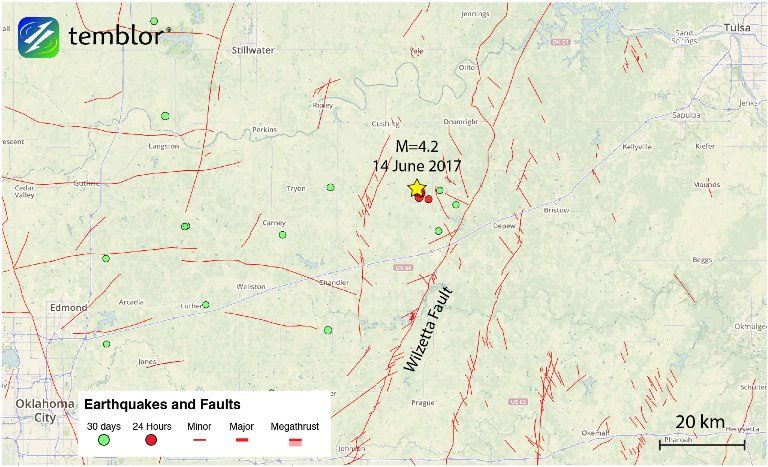
So far, there are no reports of damage, which is unlikely given this quake's moderate magnitude. Additionally, the USGS PAGER system estimates that economic losses should remain extremely minimal, and any fatalities are very unlikely.
According to the USGS, today's earthquake occurred at a depth of 9.3 km, and was right-lateral strike-slip in nature. This depth is relatively deep for Oklahoma, but still within the range frequently seen. Based on the fault map shown in the Temblor map above, and the strike-slip component of today's earthquake, it occurred on an unmapped fault in the region.
However, the orientation of the structure on which the quake struck is consistent with the regional compression direction outlined in Walsh and Zoback, 2016. Also labeled in the Temblor map is the large northeast-southwest-trending Wilzetta Fault. Based on this fault's strike (northeast-southwest) and the regional compression, it is not at the preferred orientation to undergo a large rupture. This is good as given its length, it is capable of producing a large magnitude earthquake. Instead, faults with orientations similar to the fault on which today's quake occurred have a higher likelihood of rupturing.
While when most people think of earthquakes in Oklahoma, they think of induced quakes, based on Walsh and Zoback, 2016, there are no high output disposal wells in the area around today's earthquake. While it is possible that in the last two years more wells have been put in, this is unlikely since following the 2016 M=5.8 Pawnee earthquake, disposal has been limited around the state. Therefore, today's quake may have been more natural than many that occur in the state.
Because Temblor does not factor in induced seismicity into the Hazard Rank, we must examine a Petersen et al., 2017 study in which both natural and induced seismicity is factored into the likelihood of damage. The map below shows the chance of damage from an earthquake in 2017 for the entire country. What may be eye-opening is that Oklahoma City has a higher likelihood of experiencing earthquake damage this year than both San Francisco and Los Angeles.
References
USGS
F. Rall Walsh, III, and Mark D. Zoback, Probabilistic assessment of potential fault slip related to injection-induced earthquakes: Application to north-central Oklahoma, USA, 2016, Geology, doi:10.1130/G38275.1
Mark D. Petersen, Charles S. Mueller, Morgan P. Moschetti, Susan M. Hoover, Allison M. Shumway, Daniel E. McNamara, Robert A. Williams, Andrea L. Llenos, William L. Ellsworth, Andrew J. Michael, Justin L. Rubinstein, Arthur F. McGarr, and Kenneth S. Rukstales, 2017 One-Year Seismic-Hazard Forecast for the Central and Eastern United States from Induced and Natural Earthquakes, Seismological Research Letters, March 2017; 88 (2A), DOI: 10.1785/0220170005



Reader Comments
to our Newsletter